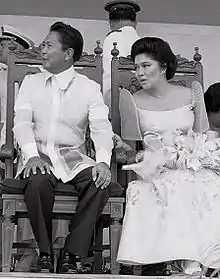Old Nayong Pilipino
The Old Nayong Pilipino, officially the Nayong Pilipino Cultural Park, was a cultural theme park near the Ninoy Aquino International Airport in Pasay, Metro Manila.
| Location | Pasay, Metro Manila, Philippines |
|---|---|
| Coordinates | 14°30′52″N 121°0′30″E |
| Theme | Filipino culture |
| Owner | Nayong Pilipino Foundation |
| Opened | 1970 2004 (reopening) |
| Closed | 2002 Unknown (second closing) |
| Area | 22.3 ha (55 acres) |
| Status | Removed |
Operational history
The organization that ran the theme park in Pasay, the Nayong Pilipino Foundation was established through Presidential Decree 37[1] which was issued by then-President Ferdinand Marcos on November 6, 1972.[2] The theme park itself, besides the Manila International Airport (now Ninoy Aquino International Airport) was opened in 1970.[3] The theme park proper covered an area of 22.3 hectares (55 acres) while the whole property associated with the facility measures 45.9 hectares (113 acres).[1]
The theme park was closed in 2002, after a taxiway and service road was built on 9 hectares (22 acres) of the facility for the Terminals 2 and 3 of the Ninoy Aquino International Airport.[1] The Tagalog Region, MIndanao Pavilion, Bohol area, and select Visayan sites such as the Magellan Cross were demolished.[4]
Nayong Pilipino briefly opened again on December 12, 2004 after a ₱600 thousand clearing and renovation works. By this time among the attractions that still exists were the Bicol, Cordilleras, Ilocos regions, an aviary, a children's playground, a picnic area and some lagoons. The reopening was done in line with the Christmas season.[4] The park was later closed again but a Nayong Pilipino theme park was later opened at the Clark Freeport Zone in Pampanga.[5]
The Manila International Airport Authority planned in 2012 to use the Nayong Pilipino property to expand the airport's cargo facility.[1]
Theme and attractions
The Nayong Pilipino was conceptualized by then First Lady Imelda Marcos to be a cultural theme park showcasing Filipino culture. At its peak the park was divided into six different zones or "regions"; Ilocos, Cordillera, Tagalog, Bicol, Visayas and Mindanao.[3]
The theme park was touted as the first of its kind in Southeast Asia. It featured models of tourist destinations of the country such as the Mayon Volcano in Albay province, the Banaue Rice Terraces in the Cordilleras, the historic houses of Vigan, Ilocos Sur, the Chocolate Hills of Bohol, and the Magellan's Cross in Cebu.[1]
The Museum of Ethnology was also hosted within the theme park which features mannequins in ethnic attire.[3]
References
- Santos, Tina (6 July 2012). "Nayong Pilipino property eyed as Naia cargo area". Philippine Daily Inquirer. Retrieved 30 May 2018.
- "Presidential Decree No. 37, s .1972 : Creating the Nayong Pilipino Foundation". Official Gazette of the Republic of the Philippines. 6 November 1972. Retrieved 30 May 2018.
- "Nayong Pilipino is closing down". Gulf News. 10 March 2002. Retrieved 30 May 2018.
- Araneta, Sandy (12 December 2004). "Nayong Pilipino re-opens today". The Philippine Star. Retrieved 30 May 2018.
- Torrevillas, Domini (18 December 2007). "Nayong Pilipino to open at Clark". The Philippine Star. Retrieved 30 May 2018.
